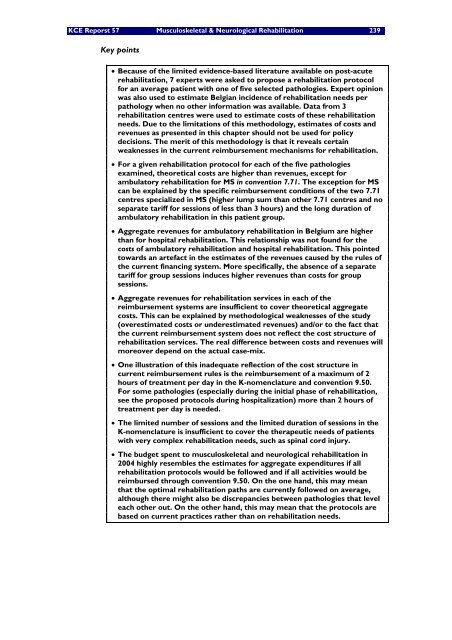The report is available in English with a French summary - KCE
The report is available in English with a French summary - KCE
The report is available in English with a French summary - KCE
You also want an ePaper? Increase the reach of your titles
YUMPU automatically turns print PDFs into web optimized ePapers that Google loves.
<strong>KCE</strong> Reporst 57 Musculoskeletal & Neurological Rehabilitation 239<br />
Key po<strong>in</strong>ts<br />
• Because of the limited evidence-based literature <strong>available</strong> on post-acute<br />
rehabilitation, 7 experts were asked to propose a rehabilitation protocol<br />
for an average patient <strong>with</strong> one of five selected pathologies. Expert op<strong>in</strong>ion<br />
was also used to estimate Belgian <strong>in</strong>cidence of rehabilitation needs per<br />
pathology when no other <strong>in</strong>formation was <strong>available</strong>. Data from 3<br />
rehabilitation centres were used to estimate costs of these rehabilitation<br />
needs. Due to the limitations of th<strong>is</strong> methodology, estimates of costs and<br />
revenues as presented <strong>in</strong> th<strong>is</strong> chapter should not be used for policy<br />
dec<strong>is</strong>ions. <strong>The</strong> merit of th<strong>is</strong> methodology <strong>is</strong> that it reveals certa<strong>in</strong><br />
weaknesses <strong>in</strong> the current reimbursement mechan<strong>is</strong>ms for rehabilitation.<br />
• For a given rehabilitation protocol for each of the five pathologies<br />
exam<strong>in</strong>ed, theoretical costs are higher than revenues, except for<br />
ambulatory rehabilitation for MS <strong>in</strong> convention 7.71. <strong>The</strong> exception for MS<br />
can be expla<strong>in</strong>ed by the specific reimbursement conditions of the two 7.71<br />
centres specialized <strong>in</strong> MS (higher lump sum than other 7.71 centres and no<br />
separate tariff for sessions of less than 3 hours) and the long duration of<br />
ambulatory rehabilitation <strong>in</strong> th<strong>is</strong> patient group.<br />
• Aggregate revenues for ambulatory rehabilitation <strong>in</strong> Belgium are higher<br />
than for hospital rehabilitation. Th<strong>is</strong> relationship was not found for the<br />
costs of ambulatory rehabilitation and hospital rehabilitation. Th<strong>is</strong> po<strong>in</strong>ted<br />
towards an artefact <strong>in</strong> the estimates of the revenues caused by the rules of<br />
the current f<strong>in</strong>anc<strong>in</strong>g system. More specifically, the absence of a separate<br />
tariff for group sessions <strong>in</strong>duces higher revenues than costs for group<br />
sessions.<br />
• Aggregate revenues for rehabilitation services <strong>in</strong> each of the<br />
reimbursement systems are <strong>in</strong>sufficient to cover theoretical aggregate<br />
costs. Th<strong>is</strong> can be expla<strong>in</strong>ed by methodological weaknesses of the study<br />
(overestimated costs or underestimated revenues) and/or to the fact that<br />
the current reimbursement system does not reflect the cost structure of<br />
rehabilitation services. <strong>The</strong> real difference between costs and revenues will<br />
moreover depend on the actual case-mix.<br />
• One illustration of th<strong>is</strong> <strong>in</strong>adequate reflection of the cost structure <strong>in</strong><br />
current reimbursement rules <strong>is</strong> the reimbursement of a maximum of 2<br />
hours of treatment per day <strong>in</strong> the K-nomenclature and convention 9.50.<br />
For some pathologies (especially dur<strong>in</strong>g the <strong>in</strong>itial phase of rehabilitation,<br />
see the proposed protocols dur<strong>in</strong>g hospitalization) more than 2 hours of<br />
treatment per day <strong>is</strong> needed.<br />
• <strong>The</strong> limited number of sessions and the limited duration of sessions <strong>in</strong> the<br />
K-nomenclature <strong>is</strong> <strong>in</strong>sufficient to cover the therapeutic needs of patients<br />
<strong>with</strong> very complex rehabilitation needs, such as sp<strong>in</strong>al cord <strong>in</strong>jury.<br />
• <strong>The</strong> budget spent to musculoskeletal and neurological rehabilitation <strong>in</strong><br />
2004 highly resembles the estimates for aggregate expenditures if all<br />
rehabilitation protocols would be followed and if all activities would be<br />
reimbursed through convention 9.50. On the one hand, th<strong>is</strong> may mean<br />
that the optimal rehabilitation paths are currently followed on average,<br />
although there might also be d<strong>is</strong>crepancies between pathologies that level<br />
each other out. On the other hand, th<strong>is</strong> may mean that the protocols are<br />
based on current practices rather than on rehabilitation needs.

















